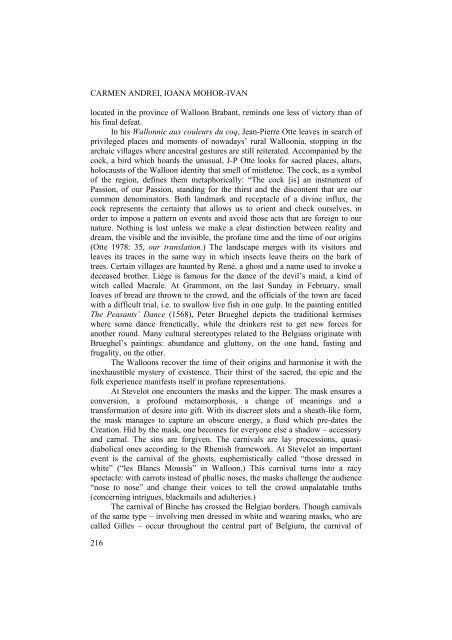culture, subculture and counterculture - Facultatea de Litere
culture, subculture and counterculture - Facultatea de Litere
culture, subculture and counterculture - Facultatea de Litere
Create successful ePaper yourself
Turn your PDF publications into a flip-book with our unique Google optimized e-Paper software.
CARMEN ANDREI, IOANA MOHOR-IVAN<br />
located in the province of Walloon Brabant, reminds one less of victory than of<br />
his final <strong>de</strong>feat.<br />
In his Wallonnie aux couleurs du coq, Jean-Pierre Otte leaves in search of<br />
privileged places <strong>and</strong> moments of nowadays’ rural Walloonia, stopping in the<br />
archaic villages where ancestral gestures are still reiterated. Accompanied by the<br />
cock, a bird which hoards the unusual, J-P Otte looks for sacred places, altars,<br />
holocausts of the Walloon i<strong>de</strong>ntity that smell of mistletoe. The cock, as a symbol<br />
of the region, <strong>de</strong>fines them metaphorically: “The cock [is] an instrument of<br />
Passion, of our Passion, st<strong>and</strong>ing for the thirst <strong>and</strong> the discontent that are our<br />
common <strong>de</strong>nominators. Both l<strong>and</strong>mark <strong>and</strong> receptacle of a divine influx, the<br />
cock represents the certainty that allows us to orient <strong>and</strong> check ourselves, in<br />
or<strong>de</strong>r to impose a pattern on events <strong>and</strong> avoid those acts that are foreign to our<br />
nature. Nothing is lost unless we make a clear distinction between reality <strong>and</strong><br />
dream, the visible <strong>and</strong> the invisible, the profane time <strong>and</strong> the time of our origins<br />
(Otte 1978: 35, our translation.) The l<strong>and</strong>scape merges with its visitors <strong>and</strong><br />
leaves its traces in the same way in which insects leave theirs on the bark of<br />
trees. Certain villages are haunted by René, a ghost <strong>and</strong> a name used to invoke a<br />
<strong>de</strong>ceased brother. Liège is famous for the dance of the <strong>de</strong>vil’s maid, a kind of<br />
witch called Macrale. At Grammont, on the last Sunday in February, small<br />
loaves of bread are thrown to the crowd, <strong>and</strong> the officials of the town are faced<br />
with a difficult trial, i.e. to swallow live fish in one gulp. In the painting entitled<br />
The Peasants’ Dance (1568), Peter Brueghel <strong>de</strong>picts the traditional kermises<br />
where some dance frenetically, while the drinkers rest to get new forces for<br />
another round. Many cultural stereotypes related to the Belgians originate with<br />
Brueghel’s paintings: abundance <strong>and</strong> gluttony, on the one h<strong>and</strong>, fasting <strong>and</strong><br />
frugality, on the other.<br />
The Walloons recover the time of their origins <strong>and</strong> harmonise it with the<br />
inexhaustible mystery of existence. Their thirst of the sacred, the epic <strong>and</strong> the<br />
folk experience manifests itself in profane representations.<br />
At Stevelot one encounters the masks <strong>and</strong> the kipper. The mask ensures a<br />
conversion, a profound metamorphosis, a change of meanings <strong>and</strong> a<br />
transformation of <strong>de</strong>sire into gift. With its discreet slots <strong>and</strong> a sheath-like form,<br />
the mask manages to capture an obscure energy, a fluid which pre-dates the<br />
Creation. Hid by the mask, one becomes for everyone else a shadow – accessory<br />
<strong>and</strong> carnal. The sins are forgiven. The carnivals are lay processions, quasidiabolical<br />
ones according to the Rhenish framework. At Stevelot an important<br />
event is the carnival of the ghosts, euphemistically called “those dressed in<br />
white” (“les Blancs Moussîs” in Walloon.) This carnival turns into a racy<br />
spectacle: with carrots instead of phallic noses, the masks challenge the audience<br />
“nose to nose” <strong>and</strong> change their voices to tell the crowd unpalatable truths<br />
(concerning intrigues, blackmails <strong>and</strong> adulteries.)<br />
The carnival of Binche has crossed the Belgian bor<strong>de</strong>rs. Though carnivals<br />
of the same type – involving men dressed in white <strong>and</strong> wearing masks, who are<br />
called Gilles – occur throughout the central part of Belgium, the carnival of<br />
216












